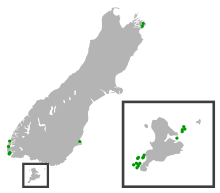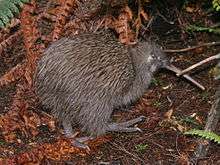South Island saddleback
| South Island saddleback | |
|---|---|
 | |
| Scientific classification | |
| Kingdom: | Animalia |
| Phylum: | Chordata |
| Class: | Aves |
| Subclass: | Neornithes |
| Infraclass: | Neognathae |
| Superorder: | Neoaves |
| Order: | Passeriformes |
| Suborder: | Passeri |
| Infraorder: | Passerida |
| Family: | Callaeidae |
| Genus: | Philesturnus |
| Species: | P. carunculatus |
| Binomial name | |
| Philesturnus carunculatus (Gmelin, 1789) | |
 | |
| Islands and sanctuaries in the South Island where South Island saddlebacks are located | |
| Synonyms | |
|
Creadion carunculatus | |
The South Island saddleback or tīeke (Philesturnus carunculatus) is a forest bird in the New Zealand wattlebird family which is endemic to the South Island of New Zealand. Both the North Island saddleback and this species were formerly considered conspecific. The Department of Conservation currently has the South Island saddleback listed as At Risk--Declining.
Distribution and habitat
During the early 19th century, South Island saddlebacks were widely distributed throughout the South and Stewart Islands. However, by the end of the century, the species was in decline and nearing extinction due to introduced predators. By 1905, the saddlebacks were confined to the South Cape Islands, off the coast of Stewart Island.[2] In 1962, ship rats were introduced to Big South Cape Island, causing the extinction of the greater short-tailed bat, Stewart Island snipe and the Stead's bush wren.
In early 1964, 36 individuals on Big South Cape Island were translocated by the New Zealand Wildlife Service to pest-free islands.[2] Big Island received 21 individuals, whilst Kaimohu Island received 15.[3] Further translocations and predator removal allowed the population to recover, with the current population estimated to be around 2000.[4]
Behaviour and ecology
Threats
The South Island saddleback is at risk of outbreaks of avian malaria and avian pox - two outbreaks in 2002 and 2007 resulted in high mortality rates among those infected.[5][6] Saddlebacks are especially vulnerable as they have had limited exposure to avian malaria, due to the disease's relatively short history in New Zealand.[6]
Conservation
A threatened species recovery plan was established by the Department of Conservation in 1994, with the aims of maintaining wild populations, adopting quarantine procedures, and removing predators from islands potentially suitable for translocating members of the species.[7]
References
- ↑ BirdLife International (2016). "Philesturnus carunculatus". The IUCN Red List of Threatened Species. IUCN. 2016: e.T103730490A112237914. doi:10.2305/IUCN.UK.2016-3.RLTS.T103730490A94148604.en. Retrieved 15 January 2018.
- 1 2 Hooson, Scott; Jamieson, Ian G. (2003). "The distribution and current status of New Zealand Saddleback Philesturnus carunculatus". Bird Conservation International. 13: 79–95. doi:10.1017/S0959270903003083.
- ↑ Hooson, Scott; Jamieson, Ian G. (2004). "Variation in breeding success among reintroduced island populations of South Island Saddlebacks Philesturnus carunculatus carunculatus". Ibis. 146 (3): 417–426. doi:10.1111/j.1474-919X.2004.00275.x.
- ↑ Masuda, B. M.; Jamieson, Ian G. (2013). "South Island saddleback". New Zealand Birds Online. Retrieved 18 April 2018.
- ↑ Alley, M. R.; Hale, K. A.; Cash, H.; Ha, H. J.; Howe, L. (2010). "Concurrent avian malaria and avipox virus infection in translocated South Island saddlebacks (Philesturnus carunculatus carunculatus)". New Zealand Veterinary Journal. 58 (4): 218–223. doi:10.1080/00480169.2010.68868.
- 1 2 Hale, Katrina A. (2008). Disease outbreak amongst South Island saddlebacks (Philesturnus carunculatus carunculatus) on Long Island (PDF) (Report). Wellington, New Zealand: Department of Conservation.
- ↑ Roberts, Andy (1994). South Island saddleback recovery plan (Philesturnus carunculatus carunculatus) (PDF) (Report). Wellington, New Zealand: Department of Conservation.

